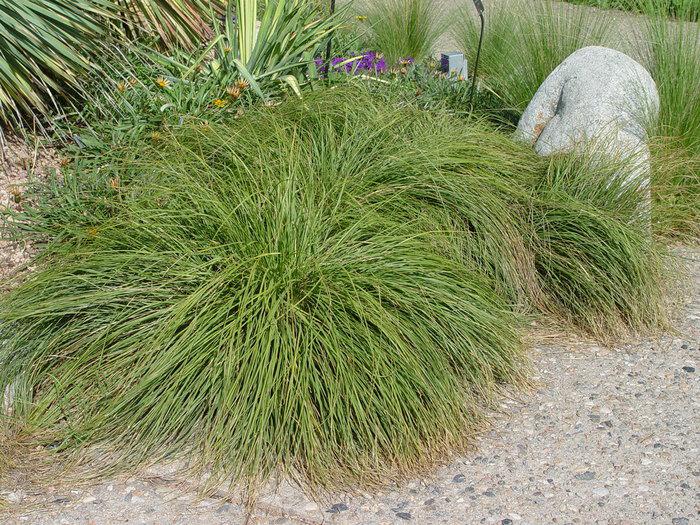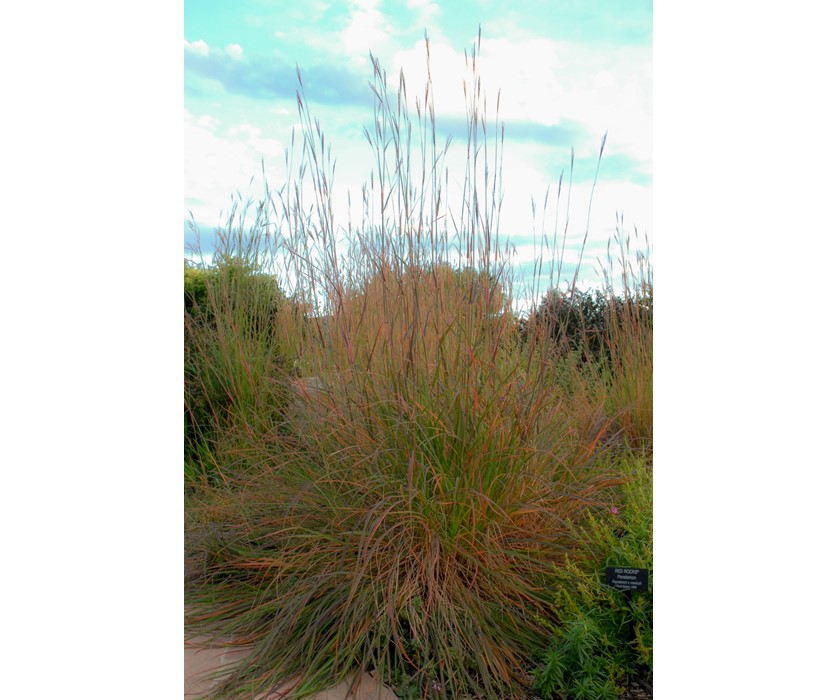By Deb Lebow Aal. Updated by Jen Smith, September 2023.
No, no, not Kentucky Blue Grass! Banish that thought and that grass – definitely not native, here. Kentucky Blue Grass (referred to from now on as KBG !!), the bane of water providers in the west, is ubiquitous, and, while it serves a purpose (it really has very few plant rivals for large areas you want to walk on), there are so many native grasses that are water thrifty, beautiful, and low maintenance, it boggles the mind that KBG is still so dang popular. As you know, wherever we have KBG, we have an ecological dead zone – it does nothing for our pollinators and birds. I recently heard Nick Daniel, horticulturist at Denver Botanic Gardens, speak at the 4th annual Landscaping with Colorado Native Plants conference, here in Denver. He spoke eloquently (and comedically!) on native grasses, and highlighted just a few of the many native grasses that should be tried in our Front Range landscapes. Here are the grasses Nick highlighted:

Buffalo Grass (Buchloe dactyloides): This is the native rival to KBG.It is a warm season grass, so it goes dormant in the cold weather (KBG is a cool season grass). Buffalo grass requires us to change what we view as a beautiful lawn. It bunches a bit, and is brown at least 6 months of the year on the Front Range. But brown is the new green! This is not a tall landscape show-stopper. This is a lawn grass. Nick claims it can be used as a border in flower beds, to frame taller perennials, instead of mulch. I’d love to see that more in practice.

Idaho Fescue (Festuca idahoensis): This is a cool season grass. This grass requires medium water, so more water than others Nick highlighted, but not nearly as much as KBG, and it is beautiful. It gets 1-3 feet tall, depending on how much water it gets. As with all these grasses, they require some water to become established – the first two years, but then they look better with minimal water. If you overwater, they flop and droop.

Prairie Dropseed (Sporabolus heterolepis): This is a medium to low water grass. It can be used in single clumps, as a border, or massed, so quite versatile. It gets 2-4 feet high, again depending on watering. A warm season grass.

Alkali Sacaton (Sporobolus airodes): A medium to low water user, it does seed around a little, which means you have to pay a bit more attention. I find it easy to take grasses out where I don’t want them and put them where I do want, if I get to them early enough. This one grows 3-4 feet tall and 2 feet wide, and the birds love it. It is extremely tough and long lived. A warm season grass.

Purple Threeawn (Aristida purpurea): This one is short lived, but have no fear. It seeds around aggressively, so you’ll always have new grasses to plant. It grows usually about a foot tall, although with overwatering can get up to 3 feet tall. Best suited for xeric and rocky gardens. A warm season grass.

Big Bluestem (Andropogon gerardii): A low water user, it can get from 3 to 8 (!) feet tall. Nick recommends keeping this one dry so it doesn’t get that tall and doesn’t flop. There is a wide variety of color and height.

Little Bluestem (Schizachyrium scoparium): Low to very low water needs. This one seeds around a bit and has extensive roots that can go 5-8 feet deep. A warm season grass. Despite the similarity in English names, this grass is not related to Big Bluestem.

Switchgrass (Panicum virgatum): I have this one all over my garden. It’s a warm season grass with medium to low water requirements, gorgeous fall color and many, many varieties.

Foxtail Barley (Hordeum jubatum): A cool season grass! This one is short-lived but very showy and very drought-tolerant. It likes full sun – most grasses do, and seeds aggressively, so deadheading is strongly advised. Foxtail barley looks best planted in swathes in meadow-type gardens. It grows from one to 3 feet tall, depending on water.

Sideoats Grama (Bouteloua curtipendula): A warm season grass, requiring low to NO water. Wow. That’s what we need (but remember, all plants need water to get established…). It’s the largest of the gramas, and seems to be getting Front Range cred. It gets from one to 3 feet tall, and is not aggressive.
These are all perennial, meaning they will come back for several to many years. Often, after a few years or too much water, they become brown and appear dead in the middle of the clump. That signals it is time to divide the grass, and get five grasses or more out of the original. Nice…
And, by the way, all these grasses need to be cut down before they start greening up again in the spring. Don’t cut them back right after they’ve gone dormant (brown). Leave them up at least through February (I cut mine back mid-March) both for winter interest and for wildlife – food and shelter.
So, banish the KBG, and maybe banish the ubiquitous Karl Foerster grass as well. Okay, it is beautiful, but it has been used absolutely everywhere and is not native to the Front Range. Nick was not shy about saying enough already with the Karl’s.
If you’d like to know more about why you should take out or reduce your KBG, read my article on lawns from November 2018. And, Thank you, Nick!
I love comments. Do you have grasses you love that are not mentioned here? Email us.
Curious to learn more about transforming your garden into a habitat with Colorado native wildflowers, grasses, shrubs, and trees? Check out our native gardening toolkit, register for an upcoming event, subscribe to our newsletter, and/or become a member – if you’re not one already!
